
Posted: 12/17/2011 9:29:36 PM EDT
[#4]
SUKHOI SU-25 " FROGFOOT"
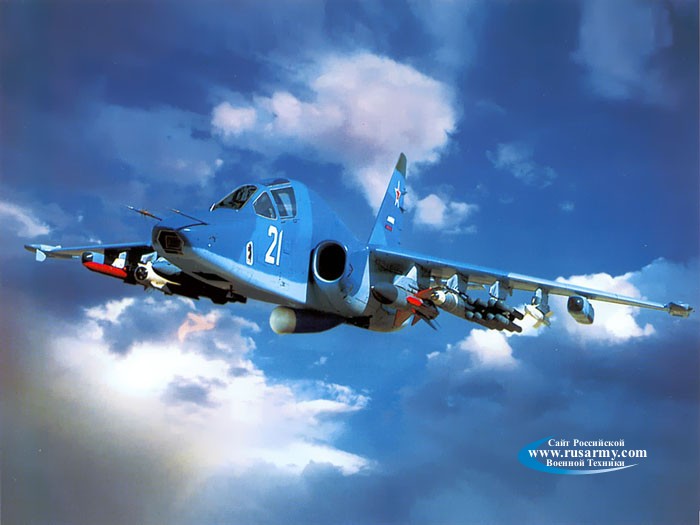
Russian Su-25TM
The Sukhoi Su-25 (NATO reporting name: Frogfoot) is a single-seat, twin-engine jet aircraft developed in the Soviet Union by the Sukhoi Design Bureau. It was designed to provide close air support for the Soviet Ground Forces. The first prototype made its maiden flight on 22 February 1975. After testing, the aircraft went into series production in 1978 at Tbilisi in the Soviet Republic of Georgia. Russian air and ground forces nicknamed it "Grach" ("Rook").
Early variants included the Su-25UB two-seat trainer, the Su-25BM for target-towing, and the Su-25K for export customers. Upgraded variants developed by Sukhoi include the Su-25T and the further improved Su-25TM (also known as Su-39). By year 2007, the Su-25 is the only armoured airplane still in production except the Su-34 whose production just started. It is currently in service with Russia and various other CIS states as well as export customers.
During its more than twenty-five years in service, the Su-25 has seen combat with several air forces. It was heavily involved in the Soviet war in Afghanistan, flying counter-insurgency missions against the Mujahideen. The Iraqi Air Force employed Su-25s against Iran during the 1980–89 Iran–Iraq War. Most of them were later destroyed or fled to Iran in the 1991 Persian Gulf War. In 1993, Abkhazian separatists used Su-25s against Georgians during the Abkhazian War. Eight years later, the Macedonian Air Force employed Su-25s against Albanian insurgents in the 2001 Macedonia conflict, and in 2008, Georgia and Russia reportedly used Su-25s in the South Ossetian conflict.
Development
In early 1968, the Soviet Ministry of Defence decided to develop a specialised shturmovik armoured assault aircraft in order to provide close air support for the Soviet Ground Forces. The idea of creating a ground-support aircraft came about after analysing the experience of shturmovaya (attack) aviation during World War II, and in local wars during the 1950s and 1960s.[4] The Soviet fighter-bombers in service or under development at this time (Su-7, Su-17, MiG-21 and MiG-23) did not meet the requirements for close air support of the army. They lacked essential armour plating to protect the pilot and vital equipment from ground fire and missile hits, and their high flight speeds made it difficult for the pilot to maintain visual contact with a target. Having taken into account these problems, Pavel Sukhoi and a group of leading specialists in the Sukhoi Design Bureau started preliminary design work in a comparatively short period of time, with the assistance of leading institutes of the Ministry of the Aviation Industry and the Ministry of Defence.
In March 1969, a competition was announced by the Soviet Air Force that called for designs for a new battlefield close-support aircraft. Participants in the competition were the Sukhoi Design Bureau and the Design Bureaus of Yakovlev, Ilyushin and Mikoyan. Sukhoi finalised its "T-8" design in late 1968, and began in work on the first two prototypes (T8-1 and T8-2) in January 1972. The T8-1, the first airframe to be assembled, was completed just before a major national holiday on 9 May 1974. However, it did not make its first flight until 22 February 1975, after a long series of test flights by Vladimir Ilyushin. The Su-25 surpassed its main competitor in the Soviet Air Force competition, the Ilyushin Il-102, and series production was announced by the Ministry of Defence.
During flight-testing phases of the T8-1 and T8-2 prototypes' development, the Sukhoi Design Bureau's management proposed that the series production of the Su-25 should start at Factory No. 31 in Tbilisi, Soviet Republic of Georgia, which at that time was the major manufacturing base for the MiG-21UM "Mongol-B" trainer. After negotiations and completion of all stages of the state trials, the Soviet Ministry of Aircraft Production authorised manufacture of the Su-25 at Tbilisi, allowing series production to start in 1978.
In the late 1980s and early 1990s, several Su-25 variants appeared, including modernised versions, and variants for specialised roles. The most significant designs were the Su-25UB dual-seat trainer, the Su-25BM target-towing variant, and the Su-25T for antitank missions. In addition, an Su-25KM prototype was developed by Georgia in co-operation with Israeli company Elbit Systems in 2001, but so far this variant has not achieved much commercial success. The Su-25 is the only armoured airplane still in production in 2007.
The Russian Air Force operates the largest number of Su-25s, and has plans to upgrade older aircraft to the Su-25SM variant. However, this process has been slowed due to a funding shortfall, by early 2007 only seven aircraft had been modified.
Design
The Su-25 has a normal aerodynamic layout with a shoulder-mounted trapezoidal wing and a conventional tailplane and rudder. Several different metals in differing amounts are used in the construction of the airframe: 60% aluminium, 19% steel, 13.5% titanium, 2% magnesium alloy, and 5.5% other materials.
 
Cockpit

su25km-2 scorpion.
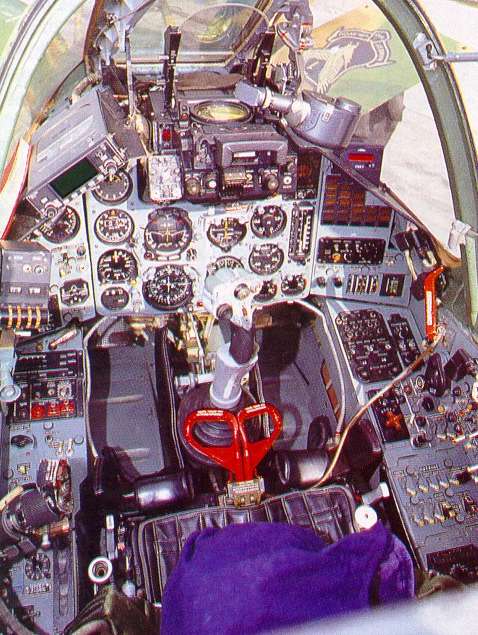
su25

su39
The pilot flies the aircraft by means of a centre stick and left hand throttles. The pilot sits on a Zvezda K-36 ejection seat (similar to the Sukhoi Su-27), and has standard flight instruments. At the rear of the cockpit is a 6 mm (0.24 in) thick steel headrest, mounted on the rear bulkhead. The cockpit has a bathtub-shaped armoured enclosure of welded titanium sheets, with transit ports located in the walls. Guide rails for the ejection seat are mounted on the rear wall of the cockpit.
The canopy hinges open to the right, and the pilot enters using the flip-down ladder. Once inside, the pilot sits low in the cockpit, protected by the bathtub assembly which makes for a cramped cockpit. Visibility from the cockpit is limited, being a trade-off for improved pilot protection. Rearwards visibility is very limited, though a periscope is fitted on top of the canopy to compensate. The basic model's cockpit control layout is rather old-fashioned. The newer Su-25TM and Su-25SM models have an upgraded avionics and weapons suite, resulting in improved survivability and combat capability.
The cannon is located in a compartment beneath the cockpit, mounted on a load-bearing beam attached to the cockpit floor and the forward fuselage support structure. An airtight avionics compartment is behind the cockpit and in front of the forward fuel tank. On the left-hand rear side of the cockpit, a built-in ladder provides access to the cockpit, the upper part of the engine nacelles, and the wing. The nose is fitted with distinctive twin pitot probes and hinges up for service access.
Wings and fuselage
All versions of the Su-25 have a metal cantilever wing, of moderate sweep and high aspect ratio, and equipped with high-lift devices. The wing consists of two cantilever sections attached to a central torsion box, forming a single unit with the fuselage. The air brakes are housed in separate fairings at the tip of each wing. Each wing has five hardpoints for weapons carriage, with the attachment points mounted on load-bearing ribs and spars. Each wing also features a five-section leading edge slat, a two-section flap, and an aileron.
The flaps are mounted by steel sliders and rollers, attached to brackets on the rear spar. The trapezoidal ailerons are located near the wingtips. The fuselage of the Su-25 has an ellipsoidal section and is of semi-monocoque, stressed-skin construction, arranged as a longitudinal load-bearing framework of longerons, beams and stringers, with a transverse load-bearing assembly of frames. The one-piece horizontal tailplane is attached to the load-bearing frame at two mounting points.



Nose views of the Su-25
Avionics
The avionics system of the Su-25 consists of several components:
* Weapons-aiming system, providing targeting data for ground munitions, as well as the targeting of aircraft in VMC: the Klen-PS laser rangefinder utilises a glass porthole in the aircraft's nose and is perhaps the most notable item of avionics. It provides a laser target designation capability whereby the pilot locks the designator onto a target through his gun-sight allowing launch of a laser-guided missile and using the Klen-PS to guide it. Dropping a laser-guided bomb would be more difficult, however, given the porthole’s forward view. This suggests that Su-25s would use "buddy designation" i.e. one aircraft standing off a safe distance to illuminate a target while the other attacked it.
* A DISS-7 Doppler radar
* Navigation system, permitting flight in day and night conditions, both in VMC and IMC, and providing flight data for the weapons-control system and flight instruments
* Radios for air-to-ground and air-to-air communications
* Weapons-control system
* Self-defence suite, incorporating infra-red, flare and chaff dispensers capable of launching about 250 flares and dipole chaff, and an SRO radar warning receiver that can alert the pilot of incoming attacks on the aircraft
* An SPO-15 radar homing & warning system (RHAWS)
* An SO-69 identification-friend-or-foe (IFF) transponder.
Variants

Su-25
The basic version of the aircraft was produced at Factory 31, at Tbilisi, in the Soviet Republic of Georgia. Between 1978 and 1989, 582 single-seat Su-25s were produced in Georgia, not including aircraft produced under the Su-25K export program. This variant of the aircraft represents the backbone of the Russian Air Force's Su-25 fleet, currently the largest in the world.
The aircraft experienced a number of accidents in operational service caused by system failures attributed to salvo firing of weapons. In the wake of these incidents, use of its main armament, the 240 mm S-24 missile, was prohibited. In its place, the FAB-500 500 kg general-purpose high-explosive bomb became the primary armament.
Su-25K
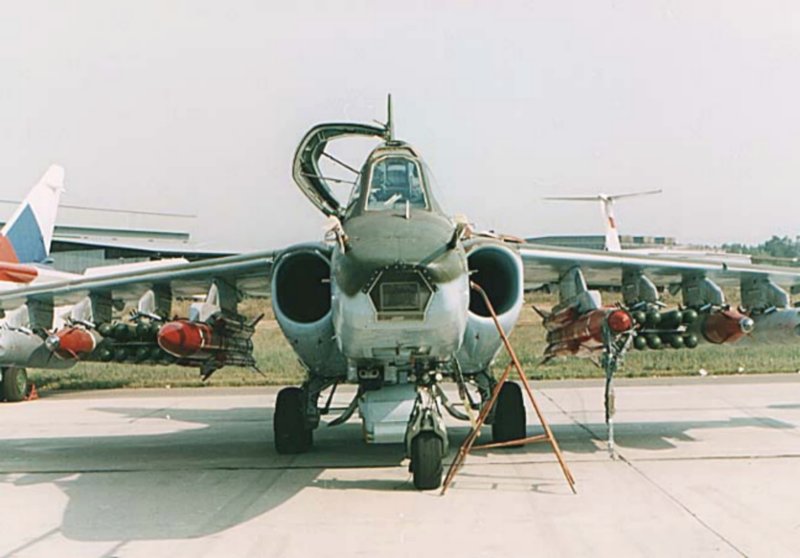
The basic Su-25 model was used as the basis for a commercial export variant, known as the Su-25K (Komercheskiy). This model was also built at Factory 31 in Tbilisi. The aircraft differed from the Soviet Air Force version in certain minor details concerning internal equipment. A total of 180 Su-25K aircraft were built between 1984 and 1989.
Su-25UB

The Su-25UB trainer (Uchebno-Boyevoy) was drawn up in 1977. The first prototype, called "T-8UB-1", was rolled out in July 1985 and its maiden flight was carried out at the Ulan-Ude factory airfield on 12 August of that year. It was intended for training and evaluation flights of active-duty pilots, and for training pilot cadets at Soviet Air Force flying schools.
The performance of the Su-25UB did not differ substantially from that of the single-seater. The navigation, attack, sighting devices and weapons-control systems of the two-seater enabled it to be used for both routine training and weapons-training missions.[31] By the end of 1986, a total of 25 Su-25UBs had been produced at Ulan-Ude, despite the fact that the twin-seater had not yet completed its State trials and therefore had not been officially cleared for service with the Soviet Air Force.
Su-25UBK

From 1986 to 1989, in parallel with the construction of the main Su-25UB combat training variant, the Ulan-Ude plant produced the so-called "commercial" Su-25UBK, intended for export to countries that bought the Su-25K, and with similar modifications to that aircraft.
Su-25UTG

The Su-25UTG (Uchebno-Trenirovochnyy s Gakom) is a variant of the Su-25UB designed to train pilots in takeoff and landing on a land-based simulated carrier deck, with a sloping ski-jump section and arrester wires. The first one flew in September 1988, and approximately 10 were produced. About half remained in Russian service after 1991, used with Russia's sole aircraft carrier, the Admiral Kuznetsov. Such a small number of aircraft were insufficient to serve the training needs of Russia's carrier air group, so a number of Su-25UBs were converted into Su-25UTGs, these aircraft being distinguished by the alternative designation Su-25UBP (Uchebno-Boyevoy Palubny) —the adjective "palubnyy" meaning "deck", indicating that these aircraft have a naval function.[35] About ten of these aircraft are currently operational in the Russian Navy as part of the 279th Naval Aviation Regiment.
Su-25BM
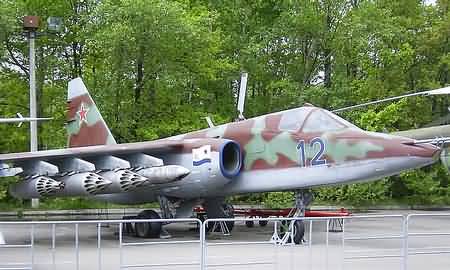
The Su-25BM (Buksirovshchik Misheney) is a target-towing variant of the Su-25 whose development began in 1986. The prototype, designated "T-8BM1", successfully flew for the first time on 22 March 1990, at Tbilisi, and the aircraft was put into production after completion of the test phase.
The Su-25BM target-tower was designed to provide towed target facilities for training ground forces and naval personnel in ground-to-air or naval surface-to-air missile systems. It is powered by an R-195 engine and equipped with an RSDN-10 long-range navigation system, an analogue of the Western LORAN system.
Su-25T


Russian Su-25TM. Carries (from tip to fuselage) R-73, R-77, 8*Vikhr, Kh-29T, Kh-58. White dome of "Kopyo" radar container is seen below, while two Omul ECM pods lie beside the aircraft.
The Su-25T (Tankovy) is a dedicated antitank version, which has been battle tested with notable success in combat missions over Chechnya. Avionics have been modified, including a sophisticated autopilot and HUD installed. It is equipped with "Shkval" TV observation and aiming system with laser rangefinder and target designator in the nose cone (the same is used on the Ka-50 attack helicopter) and may carry "Vikhr" laser beam riding AT missiles in 8-tube launchers (Ka-50 carries the same missiles in 6-tube launchers). The efficiency of this weapon system on a jet plane is disputed, as it is not a "fire-and-forget" weapon, and while a hovering helicopter may illuminate a target[citation needed] with a laser while staying at maximum range, a Su-25T flying towards its target until the "Vikhr" impact may eventually enter the range of close air defences. The night vision capabilities of "Shkval" are limited. For night operations a container with low-light TV "Merkuriy" system may be carried under the fuselage (having only 5x magnification in comparison with 23x of the "Shkval"). Alternatively, the "Fantasmagoria" passive radar sensor container may be carried, which provides targeting data for anti-radiation missiles, giving the Su-25T an air defence suppression capability. The Su-25T can also employ the KAB-500Kr TV-guided bomb and Kh-29T TV-guided heavy tactical air-to-ground missile.
A second-generation Su-25T, the Su-25TM (also designated Su-39), has been developed with improved navigation and attack systems, and better survivability. While retaining the built-in "Shkval" of Su-25T, it may carry "Kopyo" (rus. "Spear") radar in the container under fuselage, which is used for engaging air targets (with RVV-AE/R-77 missiles) as well as ships (with Kh-31 and Kh-35 antiship missiles). The Russian Air Force has received only a small number of each version so far. However, the improved avionics systems designed for these aircraft have been utilised in the Su-25SM, an interim upgrade for the series-produced Russian Air Force Su-25, resulting in superior survivability and combat capability.
Su-25KM

The SU-25KM (Kommercheskiy Modernizirovannyy), nicknamed "Scorpion", is an Su-25 upgrade programme announced in early 2001 by the original manufacturer, Tbilisi Aircraft Manufacturing in Georgia, in partnership with Elbit Systems of Israel. The prototype aircraft made its maiden flight on 18 April 2001 at Tbilisi in full Georgian Air Force markings.
The aircraft uses a standard Su-25 airframe, enhanced with advanced avionics including a glass cockpit, digital map generator, helmet-mounted display, computerised weapons system, complete mission pre-plan capability, and fully redundant backup modes. Performance enhancements include a highly accurate navigation system, pinpoint weapon delivery systems, all-weather and day/night performance, NATO compatibility, state-of-the art safety and survivability features, and advanced onboard debriefing capabilities complying with international requirements.
Su-28
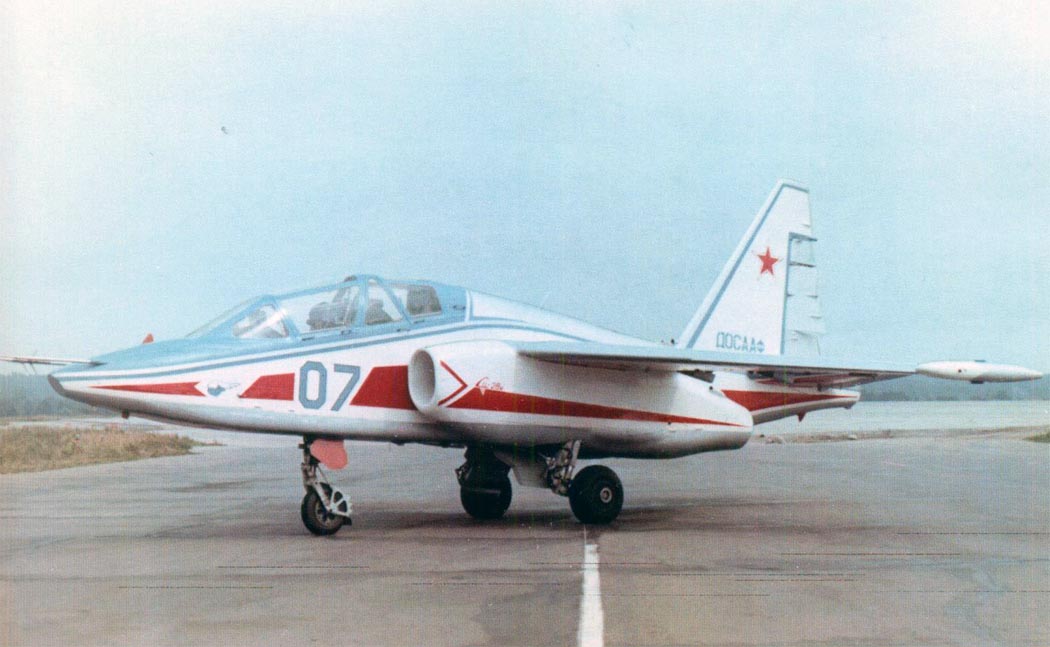
The Sukhoi Su-28 (also designated as Su-25UT - Uchebno-Trenirovochnyy) is an advanced basic jet trainer, built on the basis of the Su-25UB as a private initiative by the Sukhoi Design Bureau. The Su-28 is a light aircraft designed to replace the Czechoslovak Aero L-39 Albatros. Unlike the basic Su-25UB, it lacks a weapons-control system, built-in cannon, weapons hardpoints, and engine armour.
Other
* Su-25R (Razvedchik) – a tactical reconnaissance variant designed in 1978, but never built.
* Su-25U3 (Uchebnyy 3-myestny) – also known as the "Russian Troika", was a three-seat basic trainer aircraft. The project was suspended in 1991 due to lack of funding.
* Su-25U (Uchebnyy) – a trainer variant of Su-25s produced in Georgia between 1996 and 1998. Three aircraft were built in total, all for the Georgian Air Force.
* Su-25M1 Modernized by Ukrainian Air Force. 1 built, few more are ordered.[citation needed]
* Su-25UBM1 Modernized by Ukrainian Air Force.
Specifications (Su-25TM)
Data from Sukhoi Su-25 Frogfoot.
General characteristics
* Crew: one pilot
* Length: 15.33 m (50 ft 11)
* Wingspan: 14.36 m (47 ft 1 in)
* Height: 4.80 m (15 ft 9 in)
* Wing area: 30.1 m² (324 ft²)
* Empty weight: 10,740 kg (23,677 lb)
* Loaded weight: 16,990 kg (37,456 lb)
* Max takeoff weight: 20,500 kg (45,194 lb)
* Powerplant: 2× Tumansky R-195 turbojets, 44.18 kN (9,480 lbf) each
Performance
* Maximum speed: 950 km/h (590 mph, Mach 0.82)
* Combat radius: 375 km (235 mi)
* Ferry range: 2,500 km (1,553 mi)
* Service ceiling: 10,000 m (22,200 ft)
* Rate of climb: 58 m/s (11,400 ft/min)
* Wing loading: 584 kg/m² (119 lb/ft²)
* Thrust/weight: 0.51
Armament
* 1 × GSh-30-2 30mm cannon with 250 rounds
* 11 hardpoints for up to 4,400 kg (9,700 lb) of disposable ordnance, including rails for 2 × R-60 (AA-8 'Aphid') or other air-to-air missiles for self-defence and a wide variety of general-purpose bombs, cluster bombs, gun pods, rocket pods, laser-guided bombs, and air-to-surface missiles such as the Kh-25ML or Kh-29L.
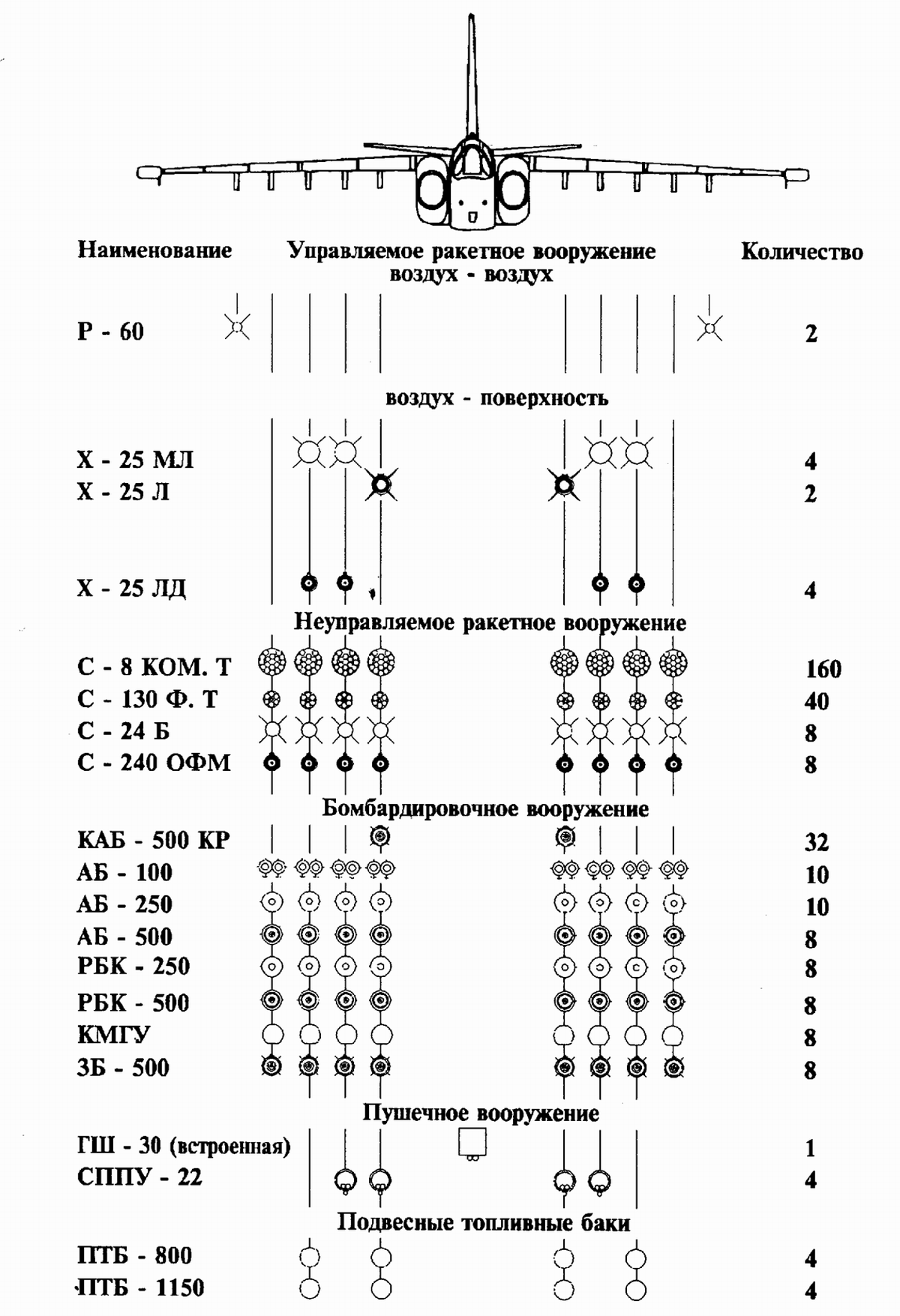

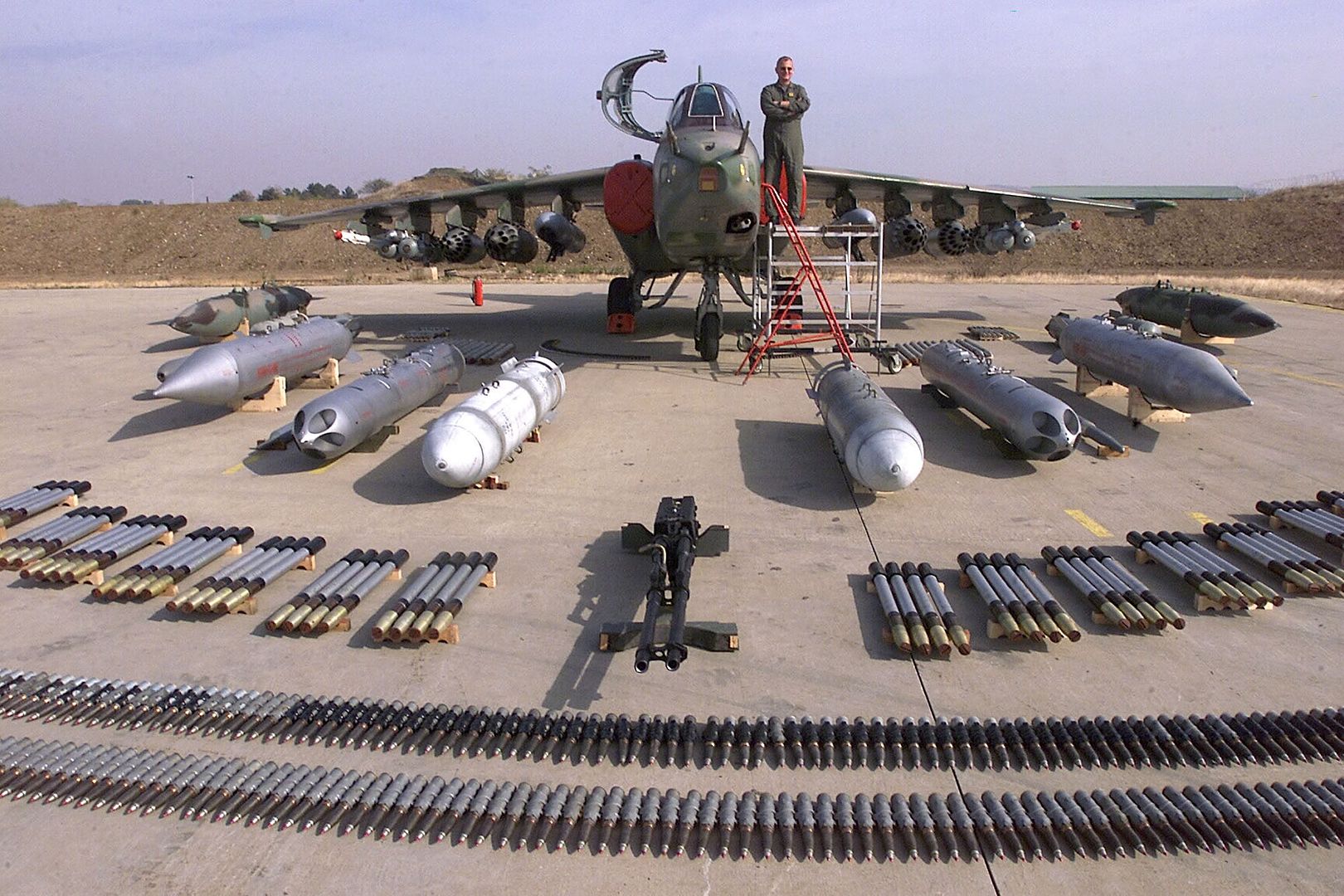

su25 drop the boms.
 
SURVIVE DIRECT HIT BY ANTI AIRCRAFT MISSILE. 
|